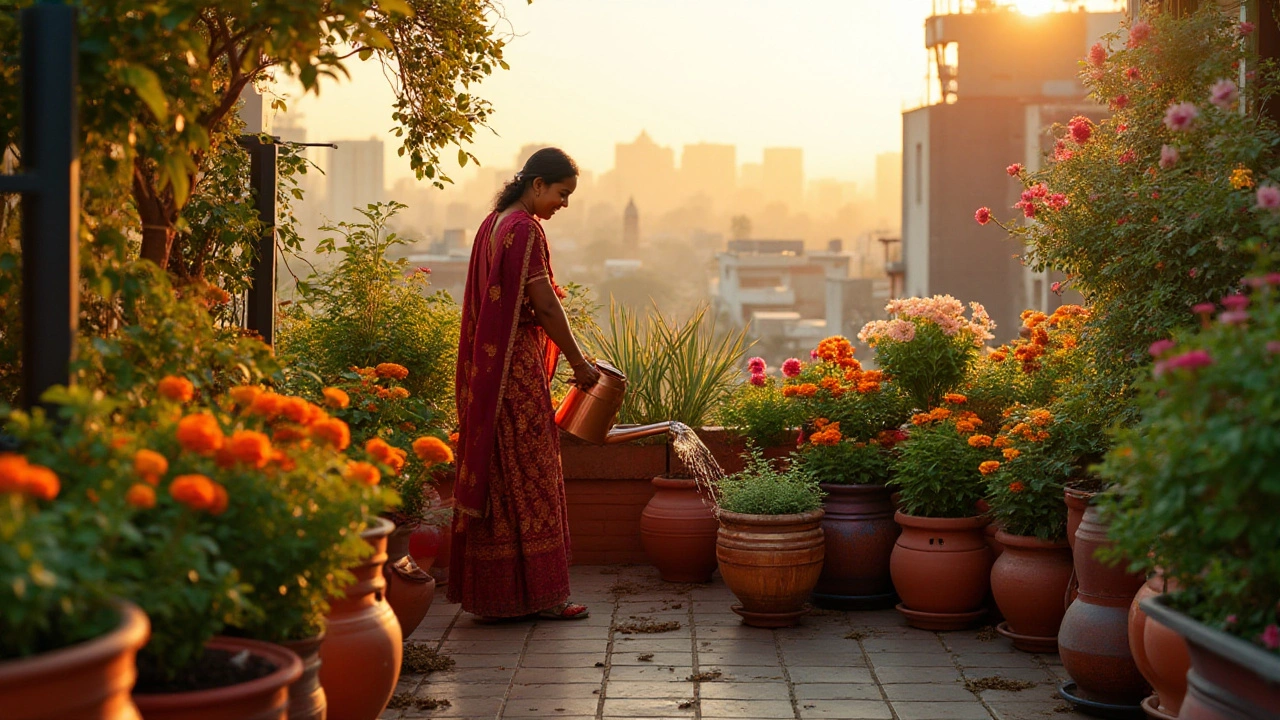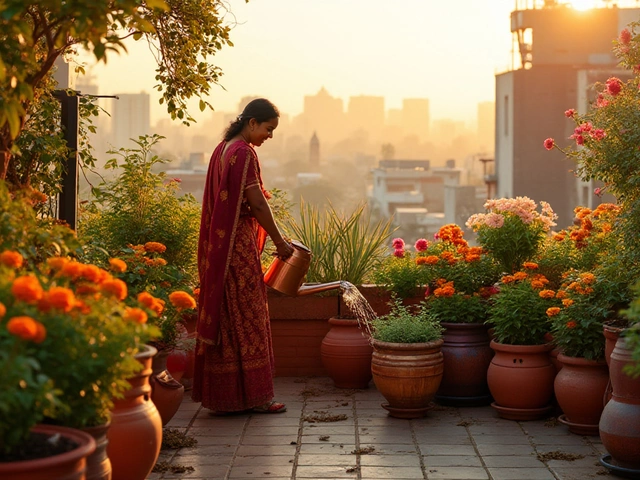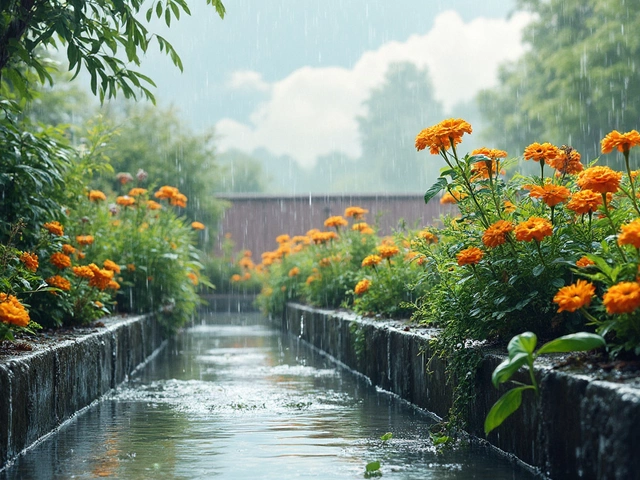Imagine stepping onto your terrace to be greeted by a lush, green view that’s the perfect escape from the concrete jungle. Terrace gardening isn't just a hobby—it's a way to cultivate a sanctuary right above your home. Creating a thriving garden in limited space requires a blend of creativity and practical knowledge.
Starting with selecting the right plants that can endure the specific conditions of your terrace is key. You need to match your selection with available sunlight and how much time you can dedicate to care. Then, consider the containers—their size and materials play a crucial role in plant health.
Watering is another factor; the challenge is to keep your plants hydrated without overdoing it. Sunlight management, a healthy soil ecosystem, and an understanding of potential pests are all vital to a successful garden. With a little guidance and patience, your terrace can transform into a vibrant, green retreat that delights all who visit.
- Choosing the Right Plants for Your Terrace
- Preparing Suitable Containers and Soil
- Effective Watering Strategies
- Sunlight and Shade Management
- Pest Control and Maintenance
- Designing Your Terrace Garden for Aesthetic Appeal
Choosing the Right Plants for Your Terrace
When it comes to creating a magnificent terrace gardening space, selecting the appropriate plants is paramount. This choice not only dictates how lush your garden will appear but also how manageable it will be through varying seasons. Start by assessing the climate conditions specific to your area, which involves understanding both the exposure to sunlight throughout the day and the changing temperatures across the year. These factors will help you select plants that are more likely to thrive in your environment, thus ensuring you’re not constantly battling against nature.
You might wonder what type of plants suit an urban setting. Succulents and cacti are favorites for beginners, requiring minimal water and thriving in sunlight, making them perfect balcony residents. Flowering plants like petunias or geraniums can add bursts of color and are surprisingly resilient. For those interested in herbs, parsley, mint, and basil grow well in containers, providing both utility and beauty. A mix of these plant types can enhance biodiversity and improve the overall health of your garden ecosystem.
Urban gardening introduces constraints especially when it comes to space. Opt for vertical planting solutions such as wall-mounted pots or tiered stands to maximize planting area on your terrace. This setup is both a space saver and a unique way to display plants. Keep in mind the notion of companion planting, where certain plants support each other’s growth. For example, planting basil near tomatoes can potentially repel pests that affect tomato plants, creating a natural ecosystem harmony on your balcony.
Another crucial aspect is choosing the right soil. Most terraces bear the burden of potted plants, which means you are solely responsible for providing all nutrients through the choice of soil mix. A high-quality potting mix can prevent issues like inadequate drainage or nutrient deficiencies. Many successful urban gardeners swear by a well-balanced mix of peat, perlite, and compost, which retains enough moisture without becoming waterlogged.
An interesting tip is to consider plant life cycles when setting up your balcony plants. Annuals will need to be replanted, offering variety each year. Perennials, though possibly less colorful, provide stability and consistency. Evergreens can keep your terrace green even in off-seasons, adding depth and texture to the garden throughout the year. When selecting your mix, think about the visual outcome as much as the practical maintenance involved.
Lastly, be prepared to experiment. Not every attempt will flourish, but each provides a learning experience. Keep track of which plants are more successful and why. This knowledge becomes invaluable as you adjust and expand your garden. Orchids or other exotic plants may appeal to adventurous gardeners once more confident. With consideration and care, your terrace garden can evolve into a vibrant testament to resilience and creativity honed right in the heart of the city.
Preparing Suitable Containers and Soil
Getting your terrace gardening off to a great start relies heavily on choosing the right containers and soil. The first step often begins with understanding that not all pots are created equal. Each container you select needs to support the specific needs of the plant it's housing, while also fitting the dimensions and aesthetics of your terrace space. Terracotta and ceramic pots are popular choices as they are breathable, allowing excess moisture to evaporate, which prevents root rot. However, they can be quite heavy, something to consider if your terrace struggles with weight capacity. If you need something lighter, consider plastic or fiberglass options, which are more portable and durable against weather extremes.
The size of your container directly impacts the plant's welfare. Small containers may be perfect for herbs like basil or thyme. In contrast, vegetables such as tomatoes or peppers require more substantial pots to allow their roots to deepen. Typically, a minimum depth of 12 inches is recommended for vegetable plants. Always look for pots with adequate drainage holes; otherwise, you'll have waterlogged plants unhappy in stagnant water.
Soil is the soul of your garden, acting as the lifeline for plants. Opting for quality potting soil over the regular garden soil is pivotal, as the latter tends to be dense and poorly draining when contained. A good potting mix available on the market usually consists of peat moss, vermiculite, or perlite, ensuring the soil is lightweight and well-aerated. Mixing slow-release fertilizers like compost into this mix can enhance nutrient availability over time.
"The right potting mix is essential for a thriving indoor and container garden," says horticulturalist Dr. Martha Stevens. "Invest in soil that provides not just good drainage but also retains enough moisture to keep roots healthy."
Depending on your choice of plants, consider the pH level and nutrients needed. Some plants, like blueberries, flourish in more acidic conditions, whereas others might prefer a neutral or slightly alkaline environment. Regularly testing your soil can help detect these requirements early on. Remember, soil texture affects water retention and consequently, plant growth. Sandy soils dry out fast, while clay-rich soils retain water longer, which can drown the roots.
| Soil Component | Purpose |
|---|---|
| Peat Moss | Retention of moisture |
| Perlite | Enhances aeration |
| Vermiculite | Improves drainage |
To wrap up, ensuring the perfect match between your containers and soil sets the foundation for a successful urban gardening venture. This preparation ultimately determines how well your plants will thrive in their somewhat unconventional home above ground level. The better you understand these essentials, the more you can control growth conditions, offering each plant the chance to reach its full potential in the bustling urban environment.
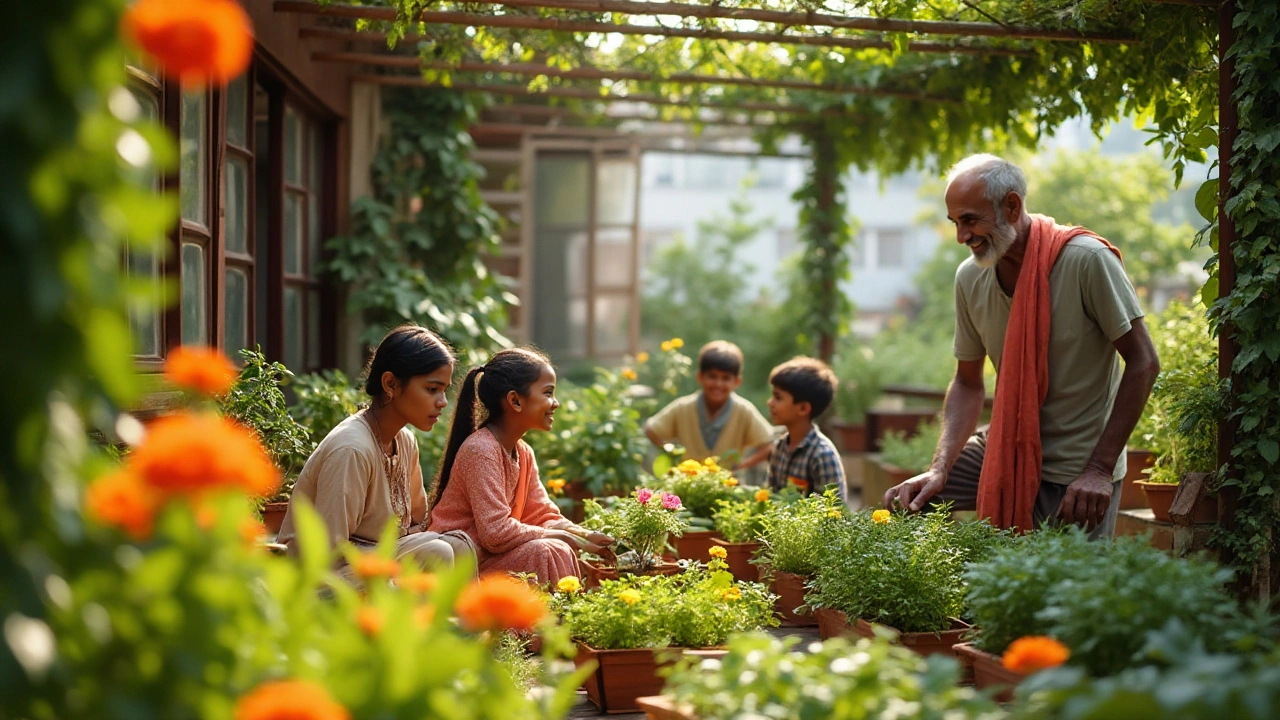
Effective Watering Strategies
Watering your terrace gardening plants properly is the lifeline that keeps them healthy and vibrant. The importance of efficient watering techniques cannot be overstated, as it forms the backbone of successful urban gardening. A well-hydrated plant can withstand hot days, resist diseases, and produce lush foliage that will transform your terrace into an oasis. Begin with understanding the needs of your plants—each species may have unique requirements. Some may thrive on weekly soaking, while others prefer a daily mist. Knowing this makes all the difference in maintaining their vitality. Observing the soil is a good practice; it should be neither too dry nor waterlogged, and a simple touch test can help determine this. A gardening enthusiast once said,
"To grow a perfect plant, you must water it as if it's your secret companion that tells you when it's thirsty."It’s crucial to anticipate these cues that your green companions subtly give.
Timing plays a critical role in watering. Early mornings or late afternoons are ideal times, primarily because water doesn’t evaporate as quickly as it would under the midday sun. It also offers plants the much-needed respite to absorb moisture effectively. Equally, it's essential to focus actions around the roots rather than the foliage, as this ensures water reaches where it’s most needed without unnecessarily wetting leaves, which could lead to fungal problems. Moreover, try employing watering tools that allow for precise delivery, like a drip irrigation system, which is both convenient and conserves water.
Let's not forget the importance of knowing when and how much to water, a skill that comes with observation and practice. Seasonal changes call for adjustments—a summertime demand will differ notably from that in cooler months. During rainy seasons, be mindful of excess water, perhaps even sheltering plans or adjusting container drainage to avoid water pooling. Checking the forecast can thus be quite beneficial. For those just starting, setting up a simple schedule could help in setting consistency, ensuring that watering becomes a seamless part of your routine.
Finally, consider the use of mulching as a strategy to retain moisture and regulate soil temperature. Not only does it conserve water, but it also enriches the soil as it breaks down, providing essential nutrients that support plant growth. Whether you opt for organic mulch like wood chips and dried leaves, or inorganic options, the results can significantly impact your urban gardening endeavors. In sum, effective watering strategies are indeed the cornerstone of creating a flourishing terrace garden, and with a bit of time and dedication, the benefits will speak for themselves.
Sunlight and Shade Management
Understanding how sunlight interacts with your terrace gardening setup is like cracking the code to plant happiness. Plants rely on sunlight for photosynthesis, the magical process that converts light into the food they need to grow and thrive. Therefore, knowing the specific light requirements of your plants is essential. Most of the time, you'll find plants categorized as full sun, partial sun, or shade-loving. Full sun plants enjoy basking in the sunlight for at least six hours a day, while partial sun plants prefer dappled light or shorter duration. Shade-loving plants can thrive with minimal direct sunlight, ideal for the hidden corners of your terrace.
Navigating the complexities of urban spaces often means balancing sunlight with available shade. A clever gardener uses tall plants to cast shade over sun-sensitive ones. This technique, known as companion planting, is a natural way to optimize light conditions for diverse plant types. If you have a larger terrace, the architecture itself might provide zones of varying light exposure. Seasonal changes also impact sunlight, with different angles and durations affecting plant growth. In the summer, people might opt for pergolas or shade cloths to protect delicate plant leaves from scorching.
According to horticultural expert Dr. Kim Smith, "Effective sunlight and shade management is crucial in terrace gardening. It can mean the difference between a thriving rooftop oasis and a collection of struggling pots." Emulating natural ecosystems by understanding these dynamics helps create a harmonious plant coexistence. However, light management isn't just about sunshine; it's equally about maximizing the use of shade and creating a microenvironment conducive to growth.
Tracking the Sun
A helpful practice is to observe and map out the sun's path on your terrace. Over a week, note which areas receive full sun and at what times. You'll realize some spots enjoy direct sun early in the morning while others soak it up in the evening. Use this information to arrange your plants accordingly. Perhaps a passionate gardener might use decorative mirrors to direct more light to shaded areas, increasing reflectivity without the need for additional space-consuming elements.
When planning a terrace garden, consider factors like the orientation of your building, as this can influence sunlight patterns. Usually, south-facing terraces receive abundant light, while north-facing ones might need shade-loving plants. Installing movable pots and planters is also useful, allowing for seasonal rearrangements to optimize sunlight exposure. By understanding and managing sunlight effectively, you not only improve plant health but also enhance your terrace's aesthetic appeal.
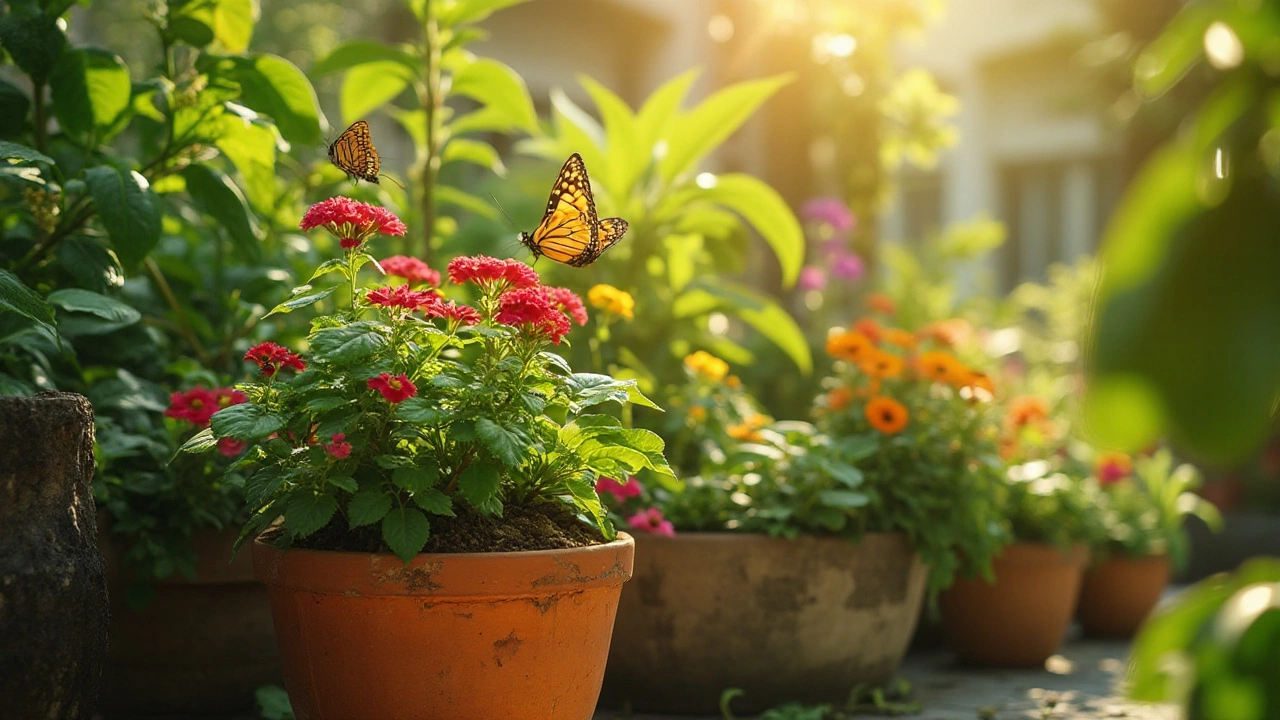
Pest Control and Maintenance
Pest control is a critical aspect of maintaining a thriving terrace garden. Common pests like aphids, whiteflies, and spider mites can wreak havoc on your urban gardening efforts if not managed proactively. To begin with, an effective strategy involves regularly inspecting your plants for any signs of pest invasion. Look underneath leaves and at the undersides of containers, as these areas often harbor insects. One method involves using a simple homemade remedy of water mixed with a few drops of dish soap. This can be sprayed directly onto the pests to reduce their numbers significantly. Encouraging beneficial insects such as ladybugs, which are natural predators of aphids, is another sustainable approach.
In addition to pest control, regular garden maintenance plays a significant role in ensuring plant health. Establish a routine that includes pruning dead or yellowing leaves, which can prevent potential fungal infections and allow plants to direct energy to new growth. It's not just about plant trimming; soil health is vital too. Consider using organic fertilizers to enrich the soil, promoting robust plant growth. Composting kitchen scraps like fruit peels and coffee grounds can provide a nutrient-rich soil amendment. If space allows, a small compost bin on your terrace can be an effective way to recycle organic waste.
Managing and maintaining proper watering schedules is crucial to terrace gardening success. Over-watering or under-watering can both be detrimental, so it's essential to be mindful of the specific needs of each plant variety you're nurturing. Introduce a drip irrigation system, which can be customized to deliver water directly to the root zones without wastage. "Pests can often take advantage of stressed plants, so well-watered, healthy plants are less inviting," notes a gardening expert from the Organic Trade Association. Monitoring humidity levels also plays a role, as some pests thrive in particular environments; knowing the ideal conditions can help tailor an effective garden management plan.
A pest control and maintenance regimen is not complete without considering repellents and deterrents. Neem oil, a natural pesticide derived from the seeds of the neem tree, can be used as an environmentally friendly option, known to deter a wide variety of pests. Companion planting can also be beneficial by utilizing strategically placed plants that naturally repel unwanted insects. For example, planting marigolds in close proximity to vegetables can help ward off nematodes. Beyond chemical controls, physical barriers such as netting can prevent pests from reaching delicate flowers and fruits while allowing sunlight and rainwater through.
Designing Your Terrace Garden for Aesthetic Appeal
Designing a terrace garden involves crafting a space that captivates the senses with beauty and tranquility. Think of your terrace as a blank canvas where every choice in color, texture, and arrangement transforms it into a personal oasis. Begin by considering the theme or mood you want to create—maybe a Mediterranean escape with lush olive trees and lavender, or a tropical paradise brimming with palms and vibrant flowers. Each theme lends itself to specific plants and materials, guiding your choices and bringing a cohesive feel to your garden.
The use of containers greatly influences the garden's aesthetics. Choose pots and planters of varying heights and textures to add depth and interest. Metallic, ceramic, and wooden finishes all bring different flavors to the space. Arranging these containers thoughtfully can create pathways, focal points, and cozy nooks, encouraging exploration and relaxation. It's important to play with levels; use plant stands, shelves, or hanging planters to make use of vertical space and draw the eye upwards.
Color is another powerful tool in garden design. Consider the color of blooms against the backdrop of your cityscape. Bright reds and oranges can inject energy, while cooler blues and purples tend to soothe. The trick is to balance bold statements with neutral tones to avoid overwhelming the senses. Remember that foliage also contributes color and texture, with some plants offering striking variegated leaves or silvery tones that catch the light beautifully.
Lighting extends the enjoyment of your garden into the evening. Fairy lights or solar lanterns hung artfully can create a magical atmosphere after sunset. Opting for LED lighting not only saves energy but also highlights key areas without overwhelming gentle night skies. Path lights can guide the way to seating areas, ensuring safety and adding a dreamy ambiance.
"Gardens are not made by singing 'Oh, how beautiful,' and sitting in the shade." — Rudyard Kipling
Incorporating natural materials in your garden's features, such as bamboo screens or stone paths, harmonizes with the living elements, creating a unified sensation of a retreat far removed from the hustle and bustle of urban life. These materials can imbue your terrace with an earthiness that complements the organic nature of the plants.
Final touches, like water features or bird feeders, not only enhance beauty but also introduce a dynamic element. The gentle sound of water trickling or birds chirping adds layers to your garden's atmosphere, inviting you to spend more time in your newly designed sanctuary. A thoughtfully designed urban garden can transform your terrace into not just a place of beauty, but a restorative sanctuary that reflects your personality and lifestyle.
